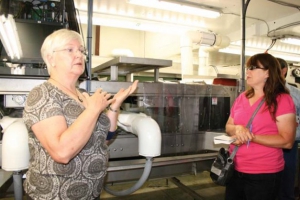
Christine Dendy (left) shows Debbie Becker and an international group of cherry industry people around her packing house at East Kelowna.
Now, with some of the latest releases from British Columbia’s cherry breeding program, such as Sovereign and Sentennial, she’s just getting started with harvest in July and will pick through the end of August. “Our whole harvest has shifted by about a month,” she told an international tour group that visited her orchard this summer. This is good, she said, because it helps her target the later market after Washington’s peak production.
Dendy has been quick to adopt Summerland’s new cherry varieties. She had the first commercial planting of Lapins before it was even named, about 30 years ago. Those blocks have been productive but are now being replaced.
Among her 70 acres of cherries, she also has some of the first Sweetheart plantings. Sweetheart tends to crop fairly heavily, she said. Early in the season, the fruit looks large. But as the summer progresses, the Sweethearts slow down, while the Lapins cherries keep growing.
Dendy’s husband, Hugh, who operates a cherry orchard in New Zealand, has found that later-maturing varieties can benefit from summer fertilization.
“What we’ve been doing in New Zealand, with some great success, is gradually feeding the trees a little bit so they don’t set terminal buds,” she explained. “I think, with some of these later varieties, we’re dealing with a tree which normally would anticipate finishing the crop at a certain time but because of the breeding program we’re getting fruit that’s a lot later. We’re having fruit that we’re trying to mature after the tree has decided summer is over and is trying to set terminal buds.”
Hugh applies nitrogen through fertilization to prevent the terminal buds from setting and to keep the tree thinking that it still needs to size the cherries, she said. She is trying the same technique in British Columbia.
Staccato
About a third of Dendy’s orchard is Staccato. She also has Sonnet, an earlier variety that looks and tastes good but is prone to splitting and sunburn and can be too soft to export.
She likes the Sylvia cherry, though it’s not self-fertile and is hard to pollinate because it blooms very late. Sam is a compatible pollinator.
“Sylvia is a really interesting cherry,” she said. “I think it’s been underplanted.”
On a Sylvia tree, the leaves tend to cover the cherries, protecting the fruit from rain, sun, and wind. Dendy said the cherries are a uniform size and shape, peaking on nine-row and larger in her experience, and look lovely in the box. Sylvia cherries ripen between Sonnet and Lapins, around mid-July.
Dendy packs all her own cherries as well as the fruit of two other orchardists. The orchard was founded in 1903 by her grandparents. Christine and Hugh took over the orchard in 1973. Until the 1970s, the fruit was sold through a cooperative packing house, but the Dendys became frustrated by how the inventory of cherries would build during the Washington cherry season, affecting the price and quality of B.C. cherries. They thought that with the new varieties that were being developed at Summerland, there was the potential for really good quality cherries at the end of the season, but the consumers never saw them because the fruit might not be shipped for two or three weeks. They began packing in the orchard to gain more control over the quality, and then later started marketing through a broker, rather than the cooperative. ‘That was a good move for us,” Dendy said.
Packing house
Their first packing house was in a log barn at the orchard that had a single belt and hydrocooler. Year by year, as production increased, the packing house had to be expanded. In 2009, she went through a major expansion and renovation to handle the bumper crop, and packed 59,000 boxes. She employs 80 to 90 people in the packing house and about 30 people in the orchard. Cherries are not harvested until they are fairly ripe so that they are more uniform in color. Pickers pick the fruit into 10-pound buckets, which are placed in bins and transported by tractor or truck to the packing house.
The cherries go first through a Fachaux stem separator and then through a roller sorter to remove the small fruit. The cherries are put back into buckets and moved into temporary cool storage before being sorted by hand. The sorting room has 58 individual stations where sorters empty the buckets of cherries into their own hoppers to remove leaves and culls and sort them into premium export grade and domestic grade. Sorters are paid piece rate and are credited for $2.20 per bucket when empty buckets are removed. If the average hourly rate works out at less than $13, Dendy raises the rate. She employs one supervisor for every eight or nine sorters.
“The incentive and quality that can be achieved through piecework is incomparable,” she said, noting that sorters can make over $1,000 a week. “People are sorting their own fruit, and you get the learning happening very quickly. If they make enough money, they want to come back.”
After being sorted, the cherries go through a hydrocooler and are sized on a Red Pearl optical sizer, which can also sort for color and identify soft cherries.
Packing a top quality product is critical, Dendy said, and her objective is to damage the cherry as little as possible between it being harvested and being put in the box. “There are enough problems that go on with cherries in the box, we want to start with the best we can.”
The packing house can handle about 2.5 to 3.0 tons per hour, or 25 tons per day. She is adding another packing line to increase flexibility and allow for bagging of cherries. The operation is GlobalGAP certified.

Leave A Comment